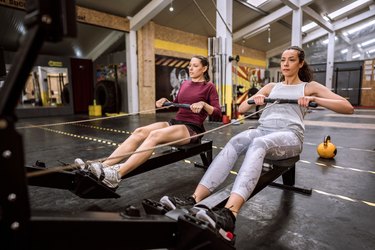
There's a reason rowing machines never truly went away. These stalwarts of fitness centers and home gyms offer low-impact workouts that burn calories and build muscles. But how does rowing machine cardio compare to other cardio options?
Rowing Builds Muscle Strength
Video of the Day
Once you begin working out on a rowing machine, one thing quickly becomes apparent. This specialized gym equipment offers a genuinely whole-body workout. In contrast to a rowboat or kayak, a rowing machine forces you to use your entire body, rather than just your upper body muscles.
Video of the Day
Your back muscles, core, shoulders, quads, glutes and hamstrings are among those muscle groups engaged in rowing. Of course, rowing machines also work your chest muscles, along with your biceps, triceps and forearm muscles.
Burning Calories
When it comes to energy exertion, rowing machine cardio is about as efficient, or somewhat more so, as other indoor exercises, according to Harvard Health Publishing. You'd burn more calories on a rowing machine than you would while taking a low-impact aerobics class or using a stair-step machine. On the other hand, rowing lines up evenly with step aerobics, stationary bicycles and circuit training in terms of calories burned.
For example, a 155-pound person can burn 260 calories per 30 minutes on a rowing machine at a moderate pace. Going more vigorously will burn about 315 calories per half-hour.
How does this compare to other types of cardio for calorie burning? On the low end of the cardio spectrum, water aerobics burns 115 calories per half-hour. In terms of super-calorie burners, a running speed of about 6.7 miles per hour burns more than 400 calories per half-hour, while vigorous outdoor cycling burns about 615 calories in the same amount of time.
Providing Instant Feedback
The American Council on Exercise Fitness notes that, compared to non-machine forms of cardio, most rowing machines offer the kind of high-tech tracking systems that activities like running and swimming lack. Most modern rowing machines allow you to see how many calories you're burning, how "far" you've rowed and/or how long you've been rowing.
In addition, you can adjust the resistance on most rowing machines by setting the damper to various positions, allowing more or less airflow. In this way, you can make the rowing more challenging as your stamina improves. If you're looking for a streamlined workout with built-in technology, rowing machine cardio may be for you.
Easing Joint Impact
For people with joint issues, rowing machines offer a chance to work out at moderate to maximum intensity without making their hips, ankles or knees bear the brunt. In order for cardio to be low impact, it will either be non-weight bearing or will feature moving parts that allow smoother, non-jarring motions. Rowing machines meet both criteria.
As a low-impact exercise, using a rowing machine is comparable to using an elliptical machine or stationary bicycle at the gym, as well as swimming, bicycling and walking. All of these, including rowing machines, are preferable to high-impact cardio activities for someone with joint issues. High-impact cardio such as jogging, playing tennis, or doing step-aerobics can be difficult for someone who has arthritis and other joint issues, notes the Mayo Clinic.
- Harvard Health Publications: Calories Burned in 30 Minutes for People of Three Different Weights
- American Council on Exercise: "Reap the Benefits of Rowing With 3 Fast and Efficient Workouts"
- ExRx: "Row Ergometer"
- YMCA Twin Cities: "A Low-Impact Way to Work 80% of Your Muscles"
- American Council on Exercise: "Equipment You’re Misusing or Not Using"
- Mayo Clinic: "Exercise Helps Ease Arthritis Pain and Stiffness"